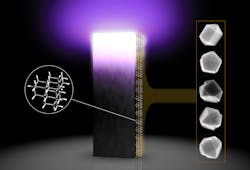How Do Synthetic Diamonds Grow?
Natural diamonds are forged by tremendous pressures and temperatures deep underground. But synthetic diamond can be grown by nucleation, where tiny bits of diamond “seed” the growth of bigger diamond crystals. Scientists at Stanford’s Linear Accelerator LAB (SLA) have seen for the first time how diamonds grow from seed at an atomic level and discovered just how big those seeds need to be to kick the crystal growing process into overdrive. The results explain how nucleation proceeds not just in diamonds, but in the atmosphere, in silicon crystals used for computer chips, and even in proteins that clump together in neurological diseases.
“Nucleation growth is a core tenet of materials science, and there’s a theory and a formula that describes how this happens in every textbook,” says Nicholas Melosh, a professor at Stanford University and DoE’s SLAC who led the research team. “It’s how we describe going from one material phase to another, such as from liquid water to ice.”
But interestingly, he says, “despite the widespread use of this process, the theory behind it had never been tested experimentally because observing how crystal growth starts from atomic-scale seeds is extremely difficult.
In fact, scientists have known for a long time that the current theory often overestimates how much energy it takes to kick off nucleation. They’ve come up with potential ways to reconcile the theory with reality, but until now those ideas have been tested only on a relatively large scale (such as with protein molecules), rather than at the atomic scale where nucleation begins.
An illustration shows how diamondoids (left), the tiniest possible specks of diamond, were used to seed the growth of nanosized diamond crystals (right). Trillions of diamondoids were attached to the surface of a silicon wafer, which was then tipped on end and exposed to a hot plasma (purple) containing carbon and hydrogen, the two elements needed to form diamond. A new study found that diamond growth really took off when seeds contained at least 26 carbon atoms. (Image courtesy of Greg Stewart/SLAC National Accelerator Laboratory)
To see how it works at the smallest scale, Melosh and his team turned to diamondoids, the tiniest possible bits of diamond. The smallest ones contain just 10 carbon atoms. These specks are the focus of a DOE-funded program at SLAC and Stanford where naturally occurring diamondoids are isolated from petroleum fluids, sorted by size and shape, and then studied. Recent experiments suggest they could be used as Lego-like blocks to assemble nanowires or “molecular anvils” for triggering chemical reactions.
The latest round of experiments was led by Stanford postdoctoral researcher Matthew Gebbie. He’s interested in the chemistry of interfaces—those places where one phase of matter encounters another, such as the boundary between air and water. It turns out that interfaces are incredibly important in growing diamonds with chemical vapor deposition (CVD), a popular method for making synthetic diamond for industry and jewelry.
To grow diamond in the lab with CVD, tiny bits of crushed diamond are seeded onto a surface and exposed to a plasma—i.e., a cloud of gas heated to such a high temperature that electrons are stripped away from their atoms. The plasma contains hydrogen and carbon, the two elements needed to form a diamond.
This plasma can either dissolve the seeds or make them grow, Gebbie says, and the competition between the two determines whether bigger crystals form. There are many ways to pack carbon atoms into a solid, but it all must be done under just the right conditions; otherwise you end up with graphite, commonly known as pencil lead, instead of sparkly diamonds.
Diamondoid seeds give scientists a much finer level of control over this process. Although they’re too small to be seen directly even with the most powerful microscopes, they can be precisely sorted according to the number of carbon atoms they contain and then chemically attached to a silicon wafer, so they are pinned in place while exposed to a plasma. The crystals that grow around the seeds eventually grow large enough to be counted under a microscope.
Although diamondoids had seeded the growth of diamonds before, these were the first experiments to test the effects of using seeds of various sizes. The team discovered that crystal growth really took off with seeds that contain at least 26 carbon atoms.
Even more important, Gebbie says, they could directly measure the energy barrier diamondoid particles must overcome to grow into crystals.
“It was thought that this barrier must be like a gigantic mountain the carbon atoms could not cross. In fact, for decades there’s been an open question of why we could even make diamonds in the first place,” he says. “What we found was more like a small hill.
“What we are really excited about and driving for is a predictable and reliable way to make diamond nanomaterials,” Gebbie adds. “Now that we’ve developed the underlying scientific knowledge needed to do that, we’ll be looking for ways to put these diamond nanomaterials to practical use.”


